Comparative Analysis of Media Articles on Suicide among Indigenous Populations
VerifiedAdded on 2019/11/08
|9
|2732
|219
Report
AI Summary
The assignment explores the notion that cultural practices may be contributing factors to high suicide rates among Indigenous Australians. Two media articles are analyzed, one with a negative influence and another with a positive impact on the Indigenous population. The discussion highlights the importance of culturally safe strategies for improving health access and experiences. It emphasizes the need for thought processes and notions about health and well-being issues to be changed solely after adjudging their truthfulness.
Contribute Materials
Your contribution can guide someone’s learning journey. Share your
documents today.
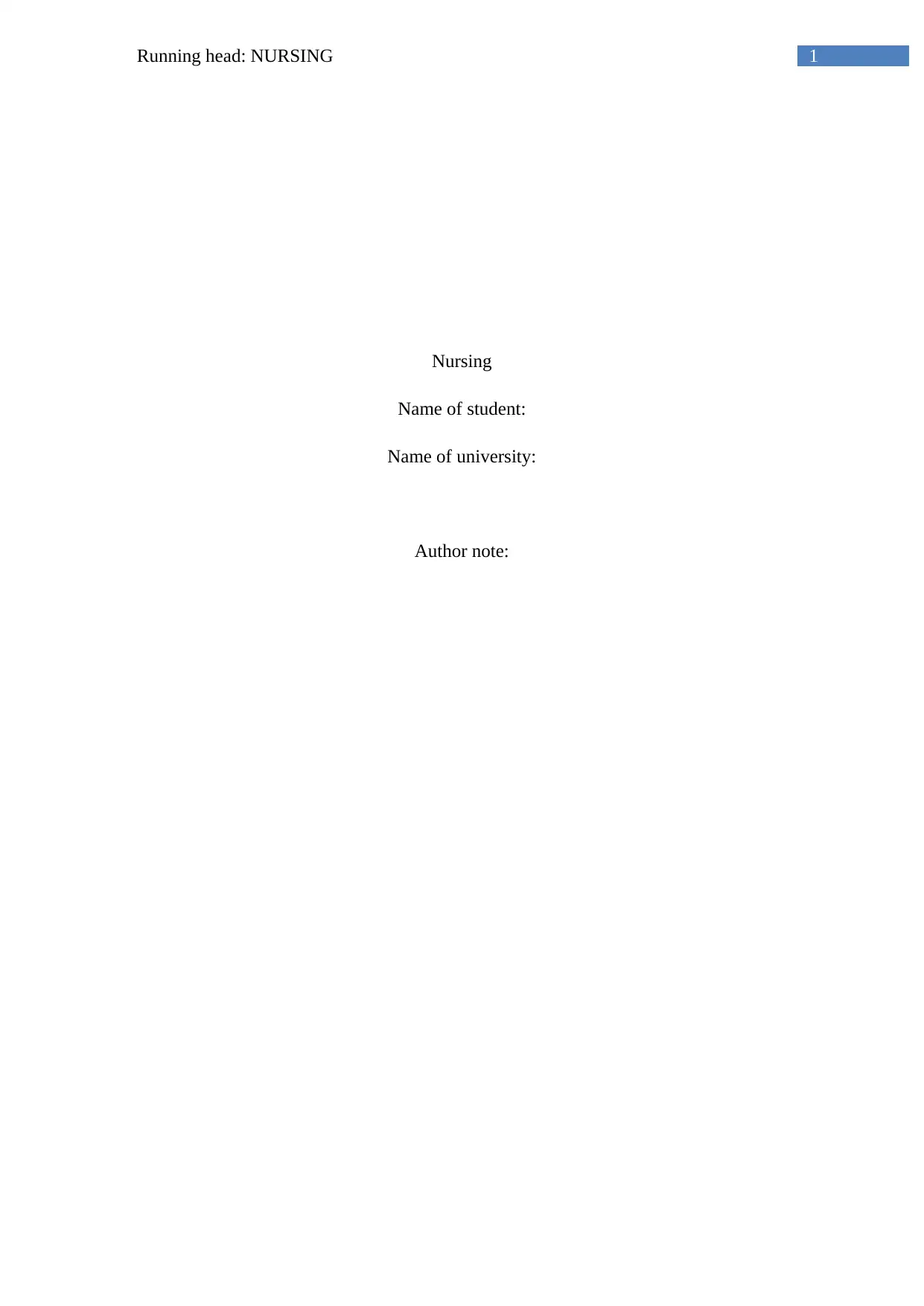
1Running head: NURSING
Nursing
Name of student:
Name of university:
Author note:
Nursing
Name of student:
Name of university:
Author note:
Secure Best Marks with AI Grader
Need help grading? Try our AI Grader for instant feedback on your assignments.
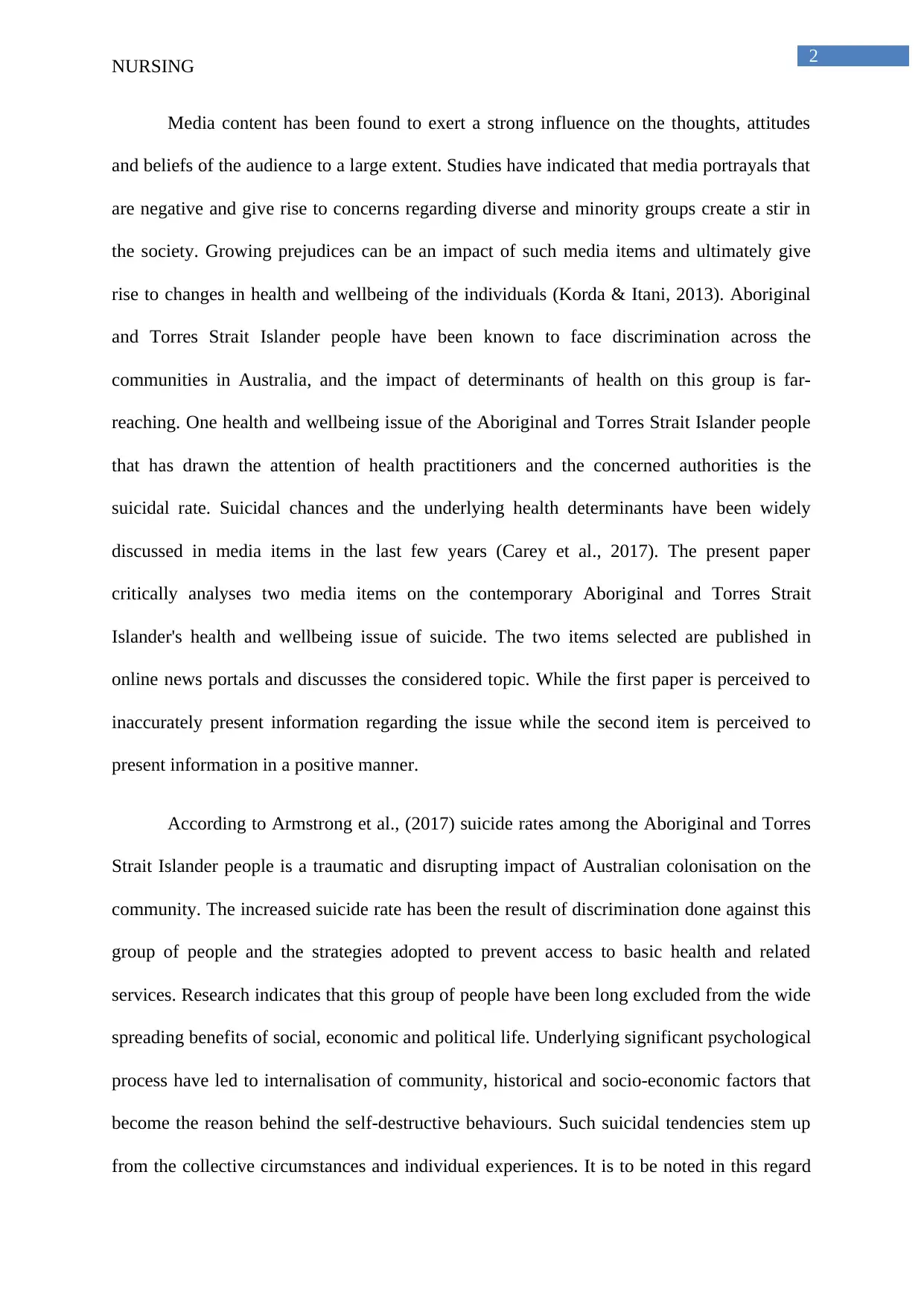
2
NURSING
Media content has been found to exert a strong influence on the thoughts, attitudes
and beliefs of the audience to a large extent. Studies have indicated that media portrayals that
are negative and give rise to concerns regarding diverse and minority groups create a stir in
the society. Growing prejudices can be an impact of such media items and ultimately give
rise to changes in health and wellbeing of the individuals (Korda & Itani, 2013). Aboriginal
and Torres Strait Islander people have been known to face discrimination across the
communities in Australia, and the impact of determinants of health on this group is far-
reaching. One health and wellbeing issue of the Aboriginal and Torres Strait Islander people
that has drawn the attention of health practitioners and the concerned authorities is the
suicidal rate. Suicidal chances and the underlying health determinants have been widely
discussed in media items in the last few years (Carey et al., 2017). The present paper
critically analyses two media items on the contemporary Aboriginal and Torres Strait
Islander's health and wellbeing issue of suicide. The two items selected are published in
online news portals and discusses the considered topic. While the first paper is perceived to
inaccurately present information regarding the issue while the second item is perceived to
present information in a positive manner.
According to Armstrong et al., (2017) suicide rates among the Aboriginal and Torres
Strait Islander people is a traumatic and disrupting impact of Australian colonisation on the
community. The increased suicide rate has been the result of discrimination done against this
group of people and the strategies adopted to prevent access to basic health and related
services. Research indicates that this group of people have been long excluded from the wide
spreading benefits of social, economic and political life. Underlying significant psychological
process have led to internalisation of community, historical and socio-economic factors that
become the reason behind the self-destructive behaviours. Such suicidal tendencies stem up
from the collective circumstances and individual experiences. It is to be noted in this regard
NURSING
Media content has been found to exert a strong influence on the thoughts, attitudes
and beliefs of the audience to a large extent. Studies have indicated that media portrayals that
are negative and give rise to concerns regarding diverse and minority groups create a stir in
the society. Growing prejudices can be an impact of such media items and ultimately give
rise to changes in health and wellbeing of the individuals (Korda & Itani, 2013). Aboriginal
and Torres Strait Islander people have been known to face discrimination across the
communities in Australia, and the impact of determinants of health on this group is far-
reaching. One health and wellbeing issue of the Aboriginal and Torres Strait Islander people
that has drawn the attention of health practitioners and the concerned authorities is the
suicidal rate. Suicidal chances and the underlying health determinants have been widely
discussed in media items in the last few years (Carey et al., 2017). The present paper
critically analyses two media items on the contemporary Aboriginal and Torres Strait
Islander's health and wellbeing issue of suicide. The two items selected are published in
online news portals and discusses the considered topic. While the first paper is perceived to
inaccurately present information regarding the issue while the second item is perceived to
present information in a positive manner.
According to Armstrong et al., (2017) suicide rates among the Aboriginal and Torres
Strait Islander people is a traumatic and disrupting impact of Australian colonisation on the
community. The increased suicide rate has been the result of discrimination done against this
group of people and the strategies adopted to prevent access to basic health and related
services. Research indicates that this group of people have been long excluded from the wide
spreading benefits of social, economic and political life. Underlying significant psychological
process have led to internalisation of community, historical and socio-economic factors that
become the reason behind the self-destructive behaviours. Such suicidal tendencies stem up
from the collective circumstances and individual experiences. It is to be noted in this regard
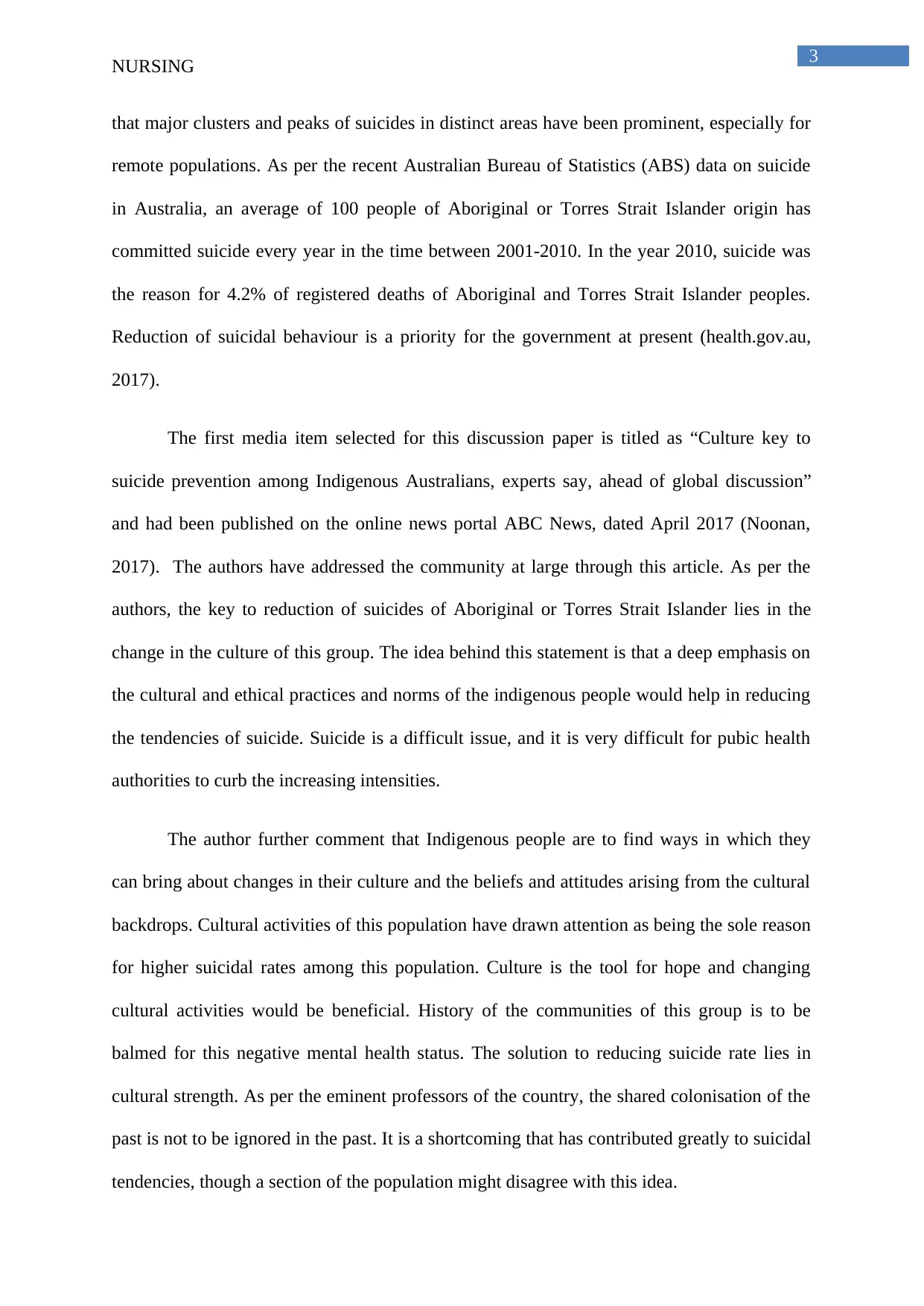
3
NURSING
that major clusters and peaks of suicides in distinct areas have been prominent, especially for
remote populations. As per the recent Australian Bureau of Statistics (ABS) data on suicide
in Australia, an average of 100 people of Aboriginal or Torres Strait Islander origin has
committed suicide every year in the time between 2001-2010. In the year 2010, suicide was
the reason for 4.2% of registered deaths of Aboriginal and Torres Strait Islander peoples.
Reduction of suicidal behaviour is a priority for the government at present (health.gov.au,
2017).
The first media item selected for this discussion paper is titled as “Culture key to
suicide prevention among Indigenous Australians, experts say, ahead of global discussion”
and had been published on the online news portal ABC News, dated April 2017 (Noonan,
2017). The authors have addressed the community at large through this article. As per the
authors, the key to reduction of suicides of Aboriginal or Torres Strait Islander lies in the
change in the culture of this group. The idea behind this statement is that a deep emphasis on
the cultural and ethical practices and norms of the indigenous people would help in reducing
the tendencies of suicide. Suicide is a difficult issue, and it is very difficult for pubic health
authorities to curb the increasing intensities.
The author further comment that Indigenous people are to find ways in which they
can bring about changes in their culture and the beliefs and attitudes arising from the cultural
backdrops. Cultural activities of this population have drawn attention as being the sole reason
for higher suicidal rates among this population. Culture is the tool for hope and changing
cultural activities would be beneficial. History of the communities of this group is to be
balmed for this negative mental health status. The solution to reducing suicide rate lies in
cultural strength. As per the eminent professors of the country, the shared colonisation of the
past is not to be ignored in the past. It is a shortcoming that has contributed greatly to suicidal
tendencies, though a section of the population might disagree with this idea.
NURSING
that major clusters and peaks of suicides in distinct areas have been prominent, especially for
remote populations. As per the recent Australian Bureau of Statistics (ABS) data on suicide
in Australia, an average of 100 people of Aboriginal or Torres Strait Islander origin has
committed suicide every year in the time between 2001-2010. In the year 2010, suicide was
the reason for 4.2% of registered deaths of Aboriginal and Torres Strait Islander peoples.
Reduction of suicidal behaviour is a priority for the government at present (health.gov.au,
2017).
The first media item selected for this discussion paper is titled as “Culture key to
suicide prevention among Indigenous Australians, experts say, ahead of global discussion”
and had been published on the online news portal ABC News, dated April 2017 (Noonan,
2017). The authors have addressed the community at large through this article. As per the
authors, the key to reduction of suicides of Aboriginal or Torres Strait Islander lies in the
change in the culture of this group. The idea behind this statement is that a deep emphasis on
the cultural and ethical practices and norms of the indigenous people would help in reducing
the tendencies of suicide. Suicide is a difficult issue, and it is very difficult for pubic health
authorities to curb the increasing intensities.
The author further comment that Indigenous people are to find ways in which they
can bring about changes in their culture and the beliefs and attitudes arising from the cultural
backdrops. Cultural activities of this population have drawn attention as being the sole reason
for higher suicidal rates among this population. Culture is the tool for hope and changing
cultural activities would be beneficial. History of the communities of this group is to be
balmed for this negative mental health status. The solution to reducing suicide rate lies in
cultural strength. As per the eminent professors of the country, the shared colonisation of the
past is not to be ignored in the past. It is a shortcoming that has contributed greatly to suicidal
tendencies, though a section of the population might disagree with this idea.
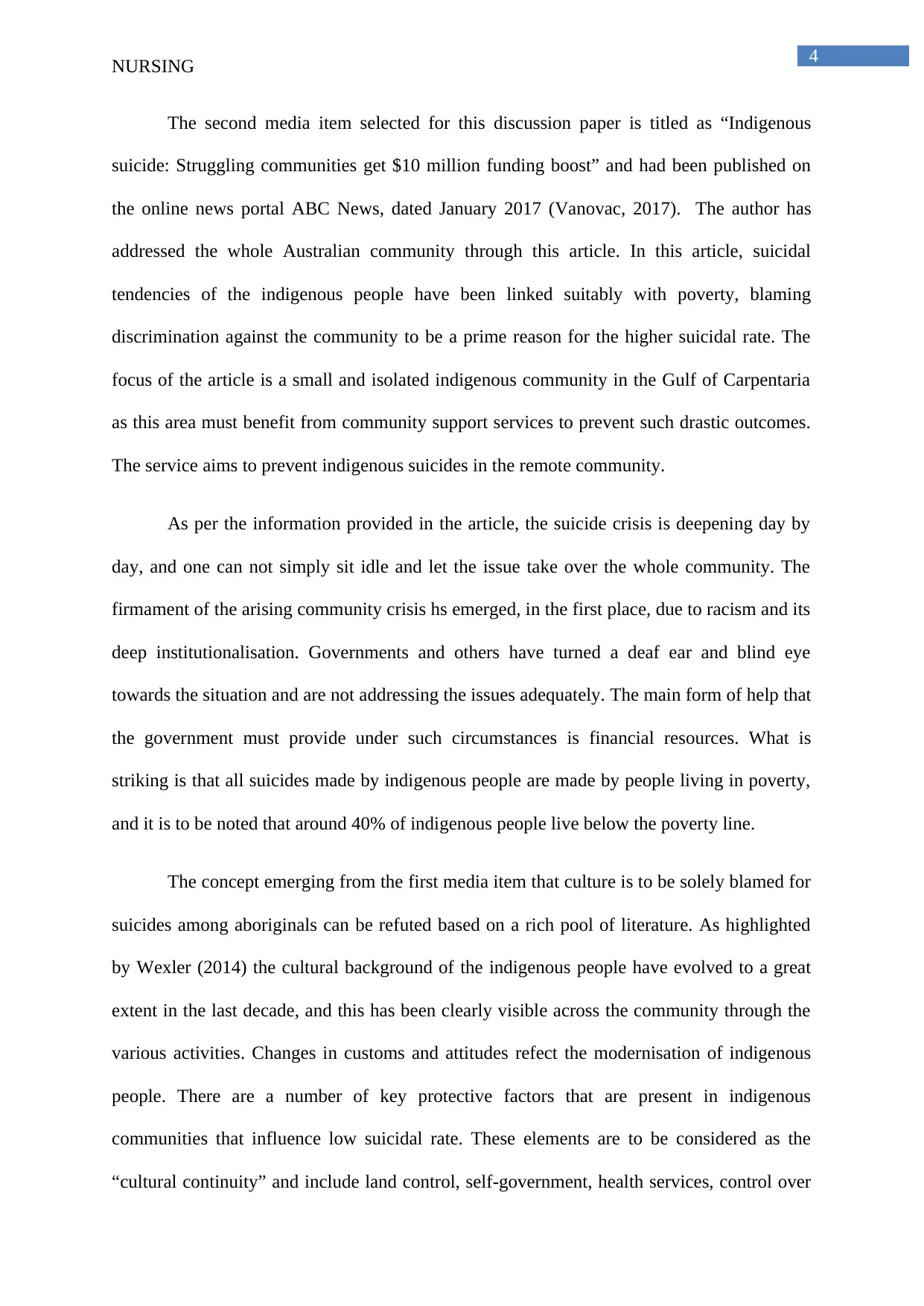
4
NURSING
The second media item selected for this discussion paper is titled as “Indigenous
suicide: Struggling communities get $10 million funding boost” and had been published on
the online news portal ABC News, dated January 2017 (Vanovac, 2017). The author has
addressed the whole Australian community through this article. In this article, suicidal
tendencies of the indigenous people have been linked suitably with poverty, blaming
discrimination against the community to be a prime reason for the higher suicidal rate. The
focus of the article is a small and isolated indigenous community in the Gulf of Carpentaria
as this area must benefit from community support services to prevent such drastic outcomes.
The service aims to prevent indigenous suicides in the remote community.
As per the information provided in the article, the suicide crisis is deepening day by
day, and one can not simply sit idle and let the issue take over the whole community. The
firmament of the arising community crisis hs emerged, in the first place, due to racism and its
deep institutionalisation. Governments and others have turned a deaf ear and blind eye
towards the situation and are not addressing the issues adequately. The main form of help that
the government must provide under such circumstances is financial resources. What is
striking is that all suicides made by indigenous people are made by people living in poverty,
and it is to be noted that around 40% of indigenous people live below the poverty line.
The concept emerging from the first media item that culture is to be solely blamed for
suicides among aboriginals can be refuted based on a rich pool of literature. As highlighted
by Wexler (2014) the cultural background of the indigenous people have evolved to a great
extent in the last decade, and this has been clearly visible across the community through the
various activities. Changes in customs and attitudes refect the modernisation of indigenous
people. There are a number of key protective factors that are present in indigenous
communities that influence low suicidal rate. These elements are to be considered as the
“cultural continuity” and include land control, self-government, health services, control over
NURSING
The second media item selected for this discussion paper is titled as “Indigenous
suicide: Struggling communities get $10 million funding boost” and had been published on
the online news portal ABC News, dated January 2017 (Vanovac, 2017). The author has
addressed the whole Australian community through this article. In this article, suicidal
tendencies of the indigenous people have been linked suitably with poverty, blaming
discrimination against the community to be a prime reason for the higher suicidal rate. The
focus of the article is a small and isolated indigenous community in the Gulf of Carpentaria
as this area must benefit from community support services to prevent such drastic outcomes.
The service aims to prevent indigenous suicides in the remote community.
As per the information provided in the article, the suicide crisis is deepening day by
day, and one can not simply sit idle and let the issue take over the whole community. The
firmament of the arising community crisis hs emerged, in the first place, due to racism and its
deep institutionalisation. Governments and others have turned a deaf ear and blind eye
towards the situation and are not addressing the issues adequately. The main form of help that
the government must provide under such circumstances is financial resources. What is
striking is that all suicides made by indigenous people are made by people living in poverty,
and it is to be noted that around 40% of indigenous people live below the poverty line.
The concept emerging from the first media item that culture is to be solely blamed for
suicides among aboriginals can be refuted based on a rich pool of literature. As highlighted
by Wexler (2014) the cultural background of the indigenous people have evolved to a great
extent in the last decade, and this has been clearly visible across the community through the
various activities. Changes in customs and attitudes refect the modernisation of indigenous
people. There are a number of key protective factors that are present in indigenous
communities that influence low suicidal rate. These elements are to be considered as the
“cultural continuity” and include land control, self-government, health services, control over
Secure Best Marks with AI Grader
Need help grading? Try our AI Grader for instant feedback on your assignments.
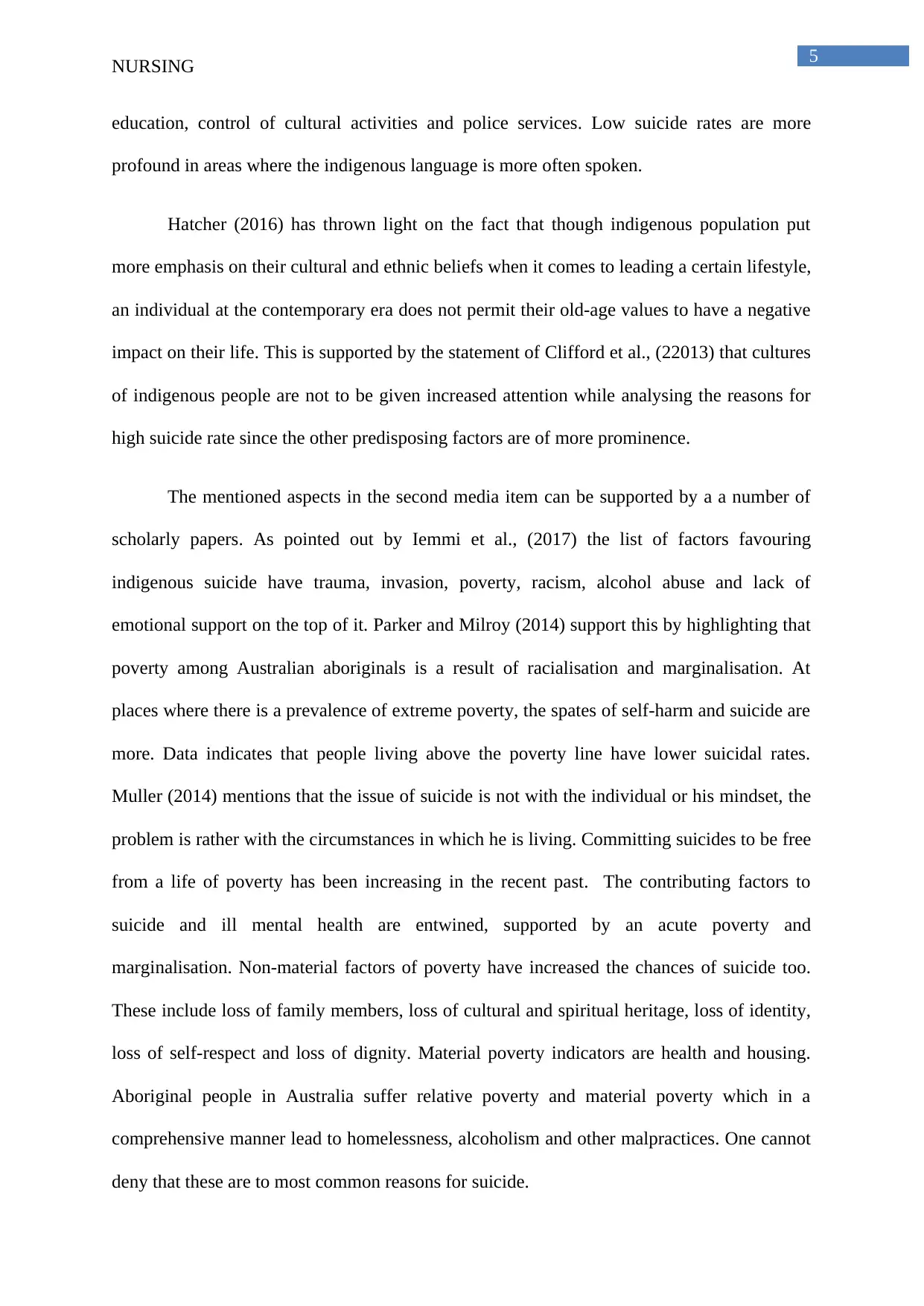
5
NURSING
education, control of cultural activities and police services. Low suicide rates are more
profound in areas where the indigenous language is more often spoken.
Hatcher (2016) has thrown light on the fact that though indigenous population put
more emphasis on their cultural and ethnic beliefs when it comes to leading a certain lifestyle,
an individual at the contemporary era does not permit their old-age values to have a negative
impact on their life. This is supported by the statement of Clifford et al., (22013) that cultures
of indigenous people are not to be given increased attention while analysing the reasons for
high suicide rate since the other predisposing factors are of more prominence.
The mentioned aspects in the second media item can be supported by a a number of
scholarly papers. As pointed out by Iemmi et al., (2017) the list of factors favouring
indigenous suicide have trauma, invasion, poverty, racism, alcohol abuse and lack of
emotional support on the top of it. Parker and Milroy (2014) support this by highlighting that
poverty among Australian aboriginals is a result of racialisation and marginalisation. At
places where there is a prevalence of extreme poverty, the spates of self-harm and suicide are
more. Data indicates that people living above the poverty line have lower suicidal rates.
Muller (2014) mentions that the issue of suicide is not with the individual or his mindset, the
problem is rather with the circumstances in which he is living. Committing suicides to be free
from a life of poverty has been increasing in the recent past. The contributing factors to
suicide and ill mental health are entwined, supported by an acute poverty and
marginalisation. Non-material factors of poverty have increased the chances of suicide too.
These include loss of family members, loss of cultural and spiritual heritage, loss of identity,
loss of self-respect and loss of dignity. Material poverty indicators are health and housing.
Aboriginal people in Australia suffer relative poverty and material poverty which in a
comprehensive manner lead to homelessness, alcoholism and other malpractices. One cannot
deny that these are to most common reasons for suicide.
NURSING
education, control of cultural activities and police services. Low suicide rates are more
profound in areas where the indigenous language is more often spoken.
Hatcher (2016) has thrown light on the fact that though indigenous population put
more emphasis on their cultural and ethnic beliefs when it comes to leading a certain lifestyle,
an individual at the contemporary era does not permit their old-age values to have a negative
impact on their life. This is supported by the statement of Clifford et al., (22013) that cultures
of indigenous people are not to be given increased attention while analysing the reasons for
high suicide rate since the other predisposing factors are of more prominence.
The mentioned aspects in the second media item can be supported by a a number of
scholarly papers. As pointed out by Iemmi et al., (2017) the list of factors favouring
indigenous suicide have trauma, invasion, poverty, racism, alcohol abuse and lack of
emotional support on the top of it. Parker and Milroy (2014) support this by highlighting that
poverty among Australian aboriginals is a result of racialisation and marginalisation. At
places where there is a prevalence of extreme poverty, the spates of self-harm and suicide are
more. Data indicates that people living above the poverty line have lower suicidal rates.
Muller (2014) mentions that the issue of suicide is not with the individual or his mindset, the
problem is rather with the circumstances in which he is living. Committing suicides to be free
from a life of poverty has been increasing in the recent past. The contributing factors to
suicide and ill mental health are entwined, supported by an acute poverty and
marginalisation. Non-material factors of poverty have increased the chances of suicide too.
These include loss of family members, loss of cultural and spiritual heritage, loss of identity,
loss of self-respect and loss of dignity. Material poverty indicators are health and housing.
Aboriginal people in Australia suffer relative poverty and material poverty which in a
comprehensive manner lead to homelessness, alcoholism and other malpractices. One cannot
deny that these are to most common reasons for suicide.
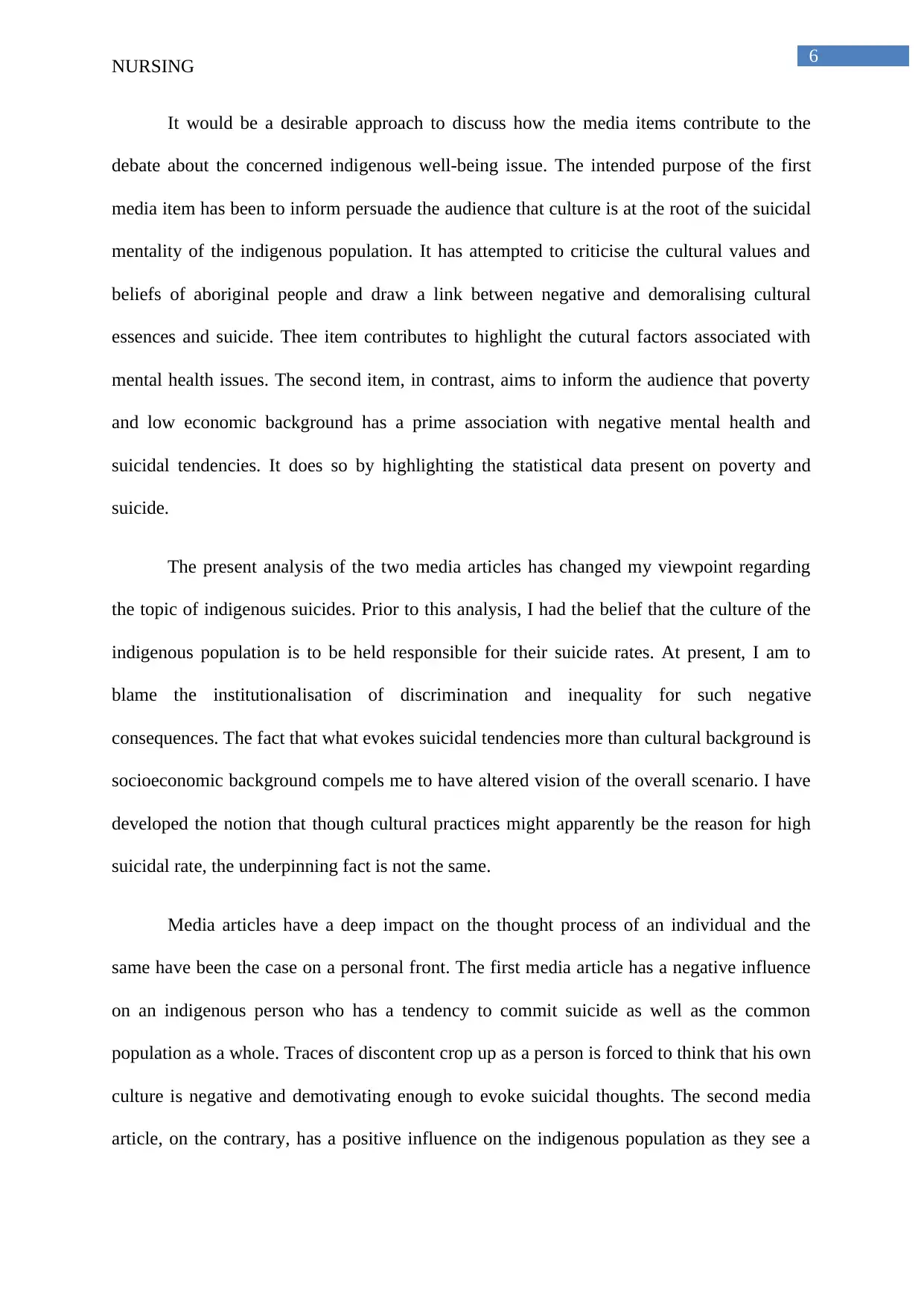
6
NURSING
It would be a desirable approach to discuss how the media items contribute to the
debate about the concerned indigenous well-being issue. The intended purpose of the first
media item has been to inform persuade the audience that culture is at the root of the suicidal
mentality of the indigenous population. It has attempted to criticise the cultural values and
beliefs of aboriginal people and draw a link between negative and demoralising cultural
essences and suicide. Thee item contributes to highlight the cutural factors associated with
mental health issues. The second item, in contrast, aims to inform the audience that poverty
and low economic background has a prime association with negative mental health and
suicidal tendencies. It does so by highlighting the statistical data present on poverty and
suicide.
The present analysis of the two media articles has changed my viewpoint regarding
the topic of indigenous suicides. Prior to this analysis, I had the belief that the culture of the
indigenous population is to be held responsible for their suicide rates. At present, I am to
blame the institutionalisation of discrimination and inequality for such negative
consequences. The fact that what evokes suicidal tendencies more than cultural background is
socioeconomic background compels me to have altered vision of the overall scenario. I have
developed the notion that though cultural practices might apparently be the reason for high
suicidal rate, the underpinning fact is not the same.
Media articles have a deep impact on the thought process of an individual and the
same have been the case on a personal front. The first media article has a negative influence
on an indigenous person who has a tendency to commit suicide as well as the common
population as a whole. Traces of discontent crop up as a person is forced to think that his own
culture is negative and demotivating enough to evoke suicidal thoughts. The second media
article, on the contrary, has a positive influence on the indigenous population as they see a
NURSING
It would be a desirable approach to discuss how the media items contribute to the
debate about the concerned indigenous well-being issue. The intended purpose of the first
media item has been to inform persuade the audience that culture is at the root of the suicidal
mentality of the indigenous population. It has attempted to criticise the cultural values and
beliefs of aboriginal people and draw a link between negative and demoralising cultural
essences and suicide. Thee item contributes to highlight the cutural factors associated with
mental health issues. The second item, in contrast, aims to inform the audience that poverty
and low economic background has a prime association with negative mental health and
suicidal tendencies. It does so by highlighting the statistical data present on poverty and
suicide.
The present analysis of the two media articles has changed my viewpoint regarding
the topic of indigenous suicides. Prior to this analysis, I had the belief that the culture of the
indigenous population is to be held responsible for their suicide rates. At present, I am to
blame the institutionalisation of discrimination and inequality for such negative
consequences. The fact that what evokes suicidal tendencies more than cultural background is
socioeconomic background compels me to have altered vision of the overall scenario. I have
developed the notion that though cultural practices might apparently be the reason for high
suicidal rate, the underpinning fact is not the same.
Media articles have a deep impact on the thought process of an individual and the
same have been the case on a personal front. The first media article has a negative influence
on an indigenous person who has a tendency to commit suicide as well as the common
population as a whole. Traces of discontent crop up as a person is forced to think that his own
culture is negative and demotivating enough to evoke suicidal thoughts. The second media
article, on the contrary, has a positive influence on the indigenous population as they see a
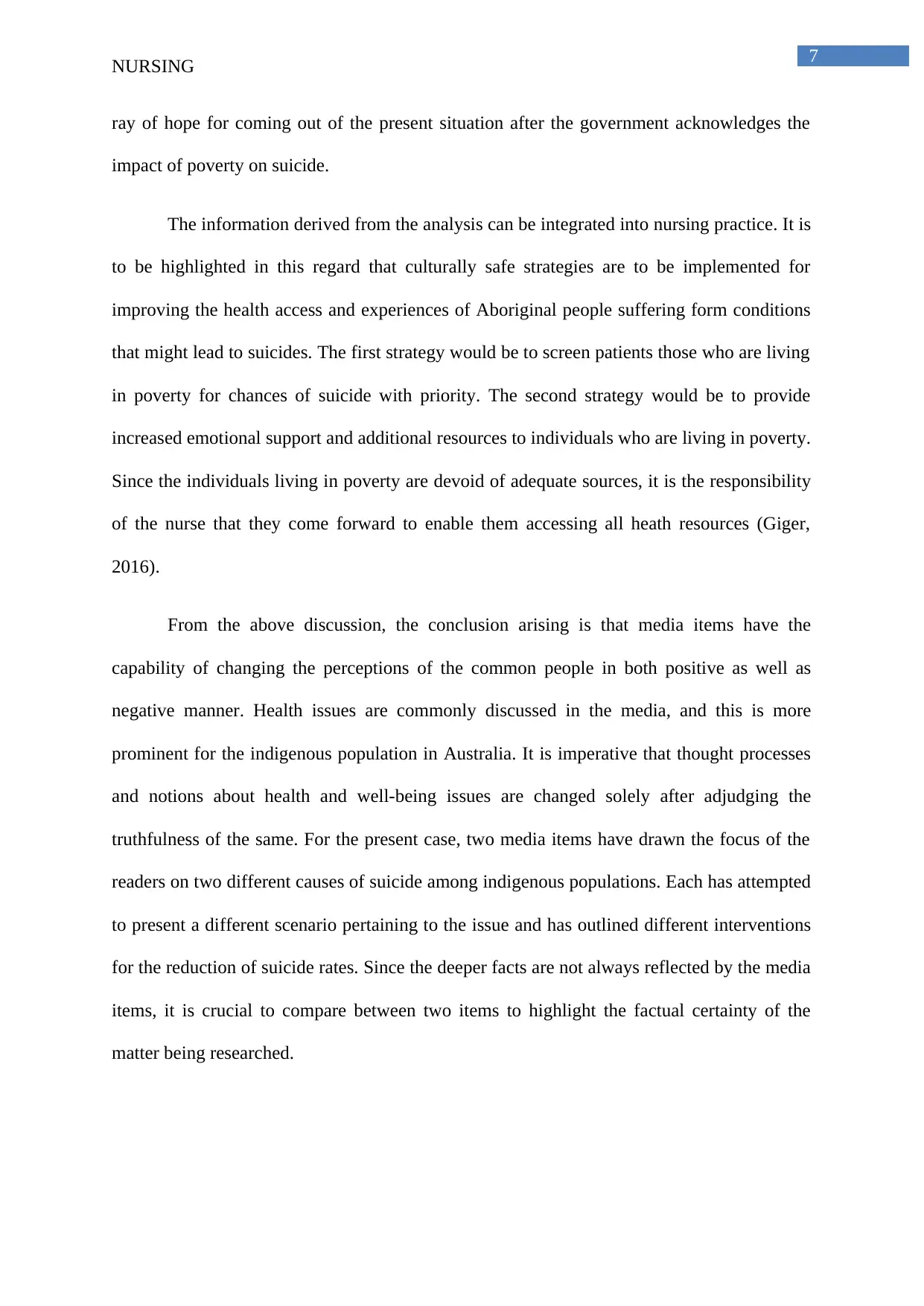
7
NURSING
ray of hope for coming out of the present situation after the government acknowledges the
impact of poverty on suicide.
The information derived from the analysis can be integrated into nursing practice. It is
to be highlighted in this regard that culturally safe strategies are to be implemented for
improving the health access and experiences of Aboriginal people suffering form conditions
that might lead to suicides. The first strategy would be to screen patients those who are living
in poverty for chances of suicide with priority. The second strategy would be to provide
increased emotional support and additional resources to individuals who are living in poverty.
Since the individuals living in poverty are devoid of adequate sources, it is the responsibility
of the nurse that they come forward to enable them accessing all heath resources (Giger,
2016).
From the above discussion, the conclusion arising is that media items have the
capability of changing the perceptions of the common people in both positive as well as
negative manner. Health issues are commonly discussed in the media, and this is more
prominent for the indigenous population in Australia. It is imperative that thought processes
and notions about health and well-being issues are changed solely after adjudging the
truthfulness of the same. For the present case, two media items have drawn the focus of the
readers on two different causes of suicide among indigenous populations. Each has attempted
to present a different scenario pertaining to the issue and has outlined different interventions
for the reduction of suicide rates. Since the deeper facts are not always reflected by the media
items, it is crucial to compare between two items to highlight the factual certainty of the
matter being researched.
NURSING
ray of hope for coming out of the present situation after the government acknowledges the
impact of poverty on suicide.
The information derived from the analysis can be integrated into nursing practice. It is
to be highlighted in this regard that culturally safe strategies are to be implemented for
improving the health access and experiences of Aboriginal people suffering form conditions
that might lead to suicides. The first strategy would be to screen patients those who are living
in poverty for chances of suicide with priority. The second strategy would be to provide
increased emotional support and additional resources to individuals who are living in poverty.
Since the individuals living in poverty are devoid of adequate sources, it is the responsibility
of the nurse that they come forward to enable them accessing all heath resources (Giger,
2016).
From the above discussion, the conclusion arising is that media items have the
capability of changing the perceptions of the common people in both positive as well as
negative manner. Health issues are commonly discussed in the media, and this is more
prominent for the indigenous population in Australia. It is imperative that thought processes
and notions about health and well-being issues are changed solely after adjudging the
truthfulness of the same. For the present case, two media items have drawn the focus of the
readers on two different causes of suicide among indigenous populations. Each has attempted
to present a different scenario pertaining to the issue and has outlined different interventions
for the reduction of suicide rates. Since the deeper facts are not always reflected by the media
items, it is crucial to compare between two items to highlight the factual certainty of the
matter being researched.
Paraphrase This Document
Need a fresh take? Get an instant paraphrase of this document with our AI Paraphraser
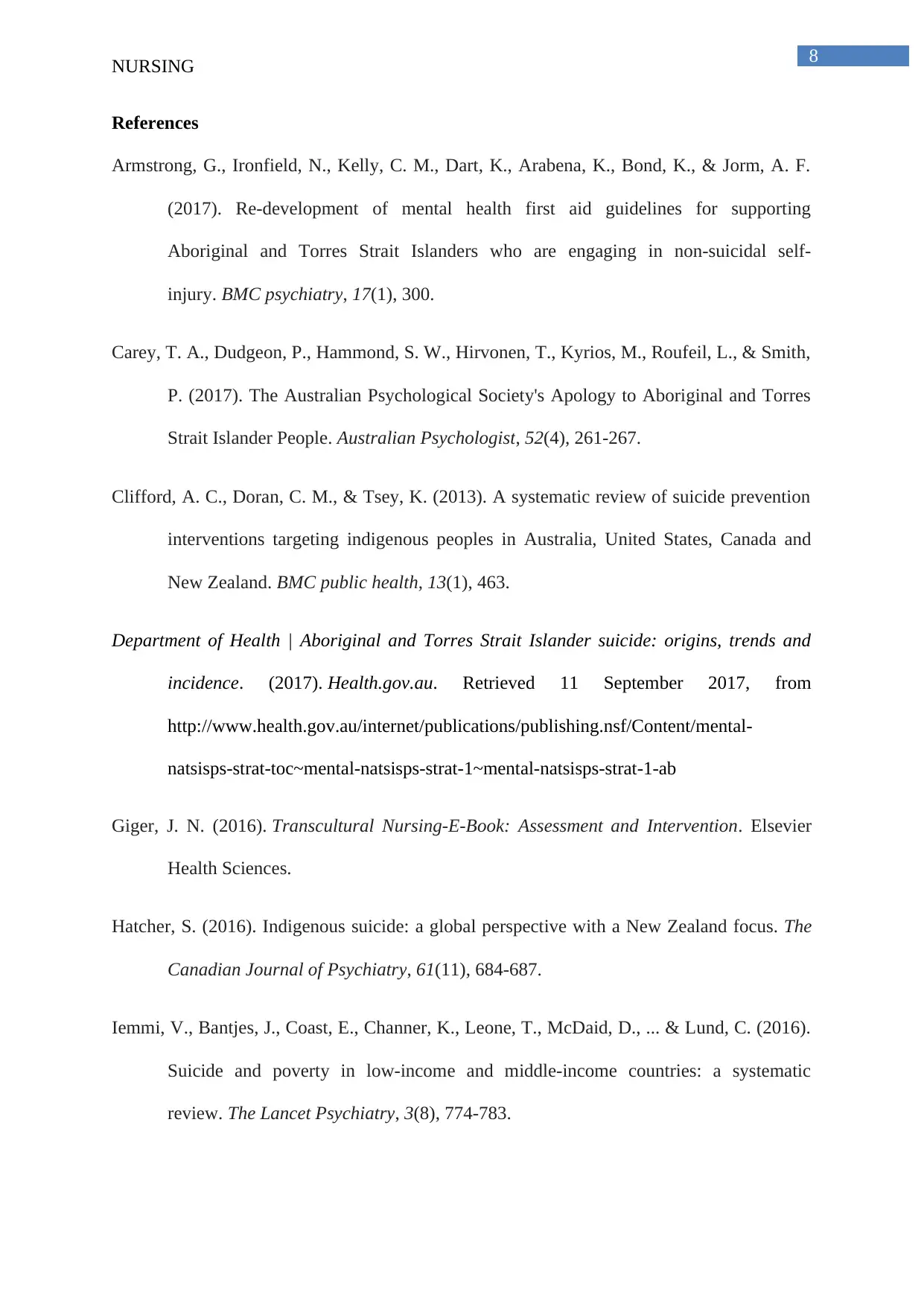
8
NURSING
References
Armstrong, G., Ironfield, N., Kelly, C. M., Dart, K., Arabena, K., Bond, K., & Jorm, A. F.
(2017). Re-development of mental health first aid guidelines for supporting
Aboriginal and Torres Strait Islanders who are engaging in non-suicidal self-
injury. BMC psychiatry, 17(1), 300.
Carey, T. A., Dudgeon, P., Hammond, S. W., Hirvonen, T., Kyrios, M., Roufeil, L., & Smith,
P. (2017). The Australian Psychological Society's Apology to Aboriginal and Torres
Strait Islander People. Australian Psychologist, 52(4), 261-267.
Clifford, A. C., Doran, C. M., & Tsey, K. (2013). A systematic review of suicide prevention
interventions targeting indigenous peoples in Australia, United States, Canada and
New Zealand. BMC public health, 13(1), 463.
Department of Health | Aboriginal and Torres Strait Islander suicide: origins, trends and
incidence. (2017). Health.gov.au. Retrieved 11 September 2017, from
http://www.health.gov.au/internet/publications/publishing.nsf/Content/mental-
natsisps-strat-toc~mental-natsisps-strat-1~mental-natsisps-strat-1-ab
Giger, J. N. (2016). Transcultural Nursing-E-Book: Assessment and Intervention. Elsevier
Health Sciences.
Hatcher, S. (2016). Indigenous suicide: a global perspective with a New Zealand focus. The
Canadian Journal of Psychiatry, 61(11), 684-687.
Iemmi, V., Bantjes, J., Coast, E., Channer, K., Leone, T., McDaid, D., ... & Lund, C. (2016).
Suicide and poverty in low-income and middle-income countries: a systematic
review. The Lancet Psychiatry, 3(8), 774-783.
NURSING
References
Armstrong, G., Ironfield, N., Kelly, C. M., Dart, K., Arabena, K., Bond, K., & Jorm, A. F.
(2017). Re-development of mental health first aid guidelines for supporting
Aboriginal and Torres Strait Islanders who are engaging in non-suicidal self-
injury. BMC psychiatry, 17(1), 300.
Carey, T. A., Dudgeon, P., Hammond, S. W., Hirvonen, T., Kyrios, M., Roufeil, L., & Smith,
P. (2017). The Australian Psychological Society's Apology to Aboriginal and Torres
Strait Islander People. Australian Psychologist, 52(4), 261-267.
Clifford, A. C., Doran, C. M., & Tsey, K. (2013). A systematic review of suicide prevention
interventions targeting indigenous peoples in Australia, United States, Canada and
New Zealand. BMC public health, 13(1), 463.
Department of Health | Aboriginal and Torres Strait Islander suicide: origins, trends and
incidence. (2017). Health.gov.au. Retrieved 11 September 2017, from
http://www.health.gov.au/internet/publications/publishing.nsf/Content/mental-
natsisps-strat-toc~mental-natsisps-strat-1~mental-natsisps-strat-1-ab
Giger, J. N. (2016). Transcultural Nursing-E-Book: Assessment and Intervention. Elsevier
Health Sciences.
Hatcher, S. (2016). Indigenous suicide: a global perspective with a New Zealand focus. The
Canadian Journal of Psychiatry, 61(11), 684-687.
Iemmi, V., Bantjes, J., Coast, E., Channer, K., Leone, T., McDaid, D., ... & Lund, C. (2016).
Suicide and poverty in low-income and middle-income countries: a systematic
review. The Lancet Psychiatry, 3(8), 774-783.
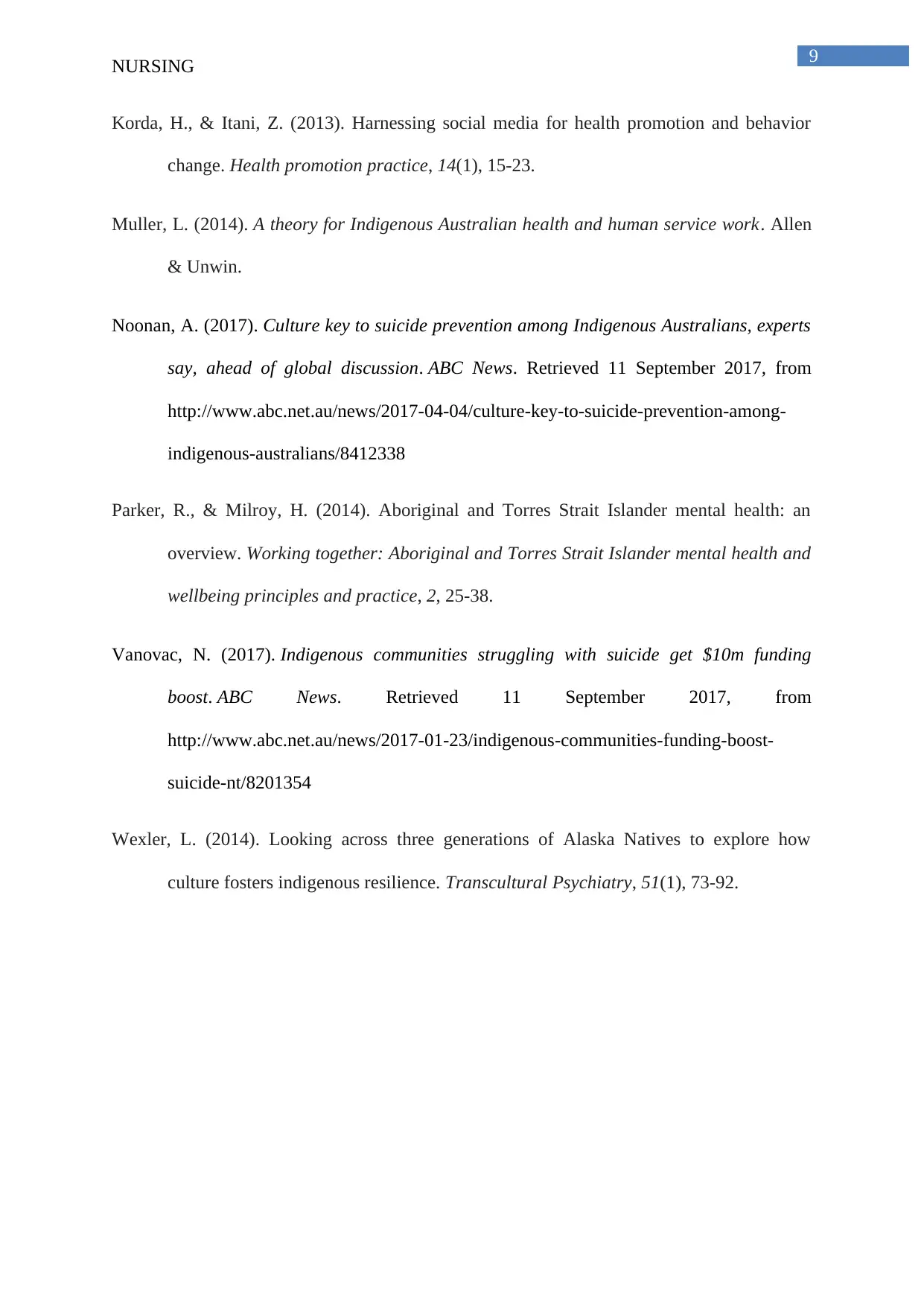
9
NURSING
Korda, H., & Itani, Z. (2013). Harnessing social media for health promotion and behavior
change. Health promotion practice, 14(1), 15-23.
Muller, L. (2014). A theory for Indigenous Australian health and human service work. Allen
& Unwin.
Noonan, A. (2017). Culture key to suicide prevention among Indigenous Australians, experts
say, ahead of global discussion. ABC News. Retrieved 11 September 2017, from
http://www.abc.net.au/news/2017-04-04/culture-key-to-suicide-prevention-among-
indigenous-australians/8412338
Parker, R., & Milroy, H. (2014). Aboriginal and Torres Strait Islander mental health: an
overview. Working together: Aboriginal and Torres Strait Islander mental health and
wellbeing principles and practice, 2, 25-38.
Vanovac, N. (2017). Indigenous communities struggling with suicide get $10m funding
boost. ABC News. Retrieved 11 September 2017, from
http://www.abc.net.au/news/2017-01-23/indigenous-communities-funding-boost-
suicide-nt/8201354
Wexler, L. (2014). Looking across three generations of Alaska Natives to explore how
culture fosters indigenous resilience. Transcultural Psychiatry, 51(1), 73-92.
NURSING
Korda, H., & Itani, Z. (2013). Harnessing social media for health promotion and behavior
change. Health promotion practice, 14(1), 15-23.
Muller, L. (2014). A theory for Indigenous Australian health and human service work. Allen
& Unwin.
Noonan, A. (2017). Culture key to suicide prevention among Indigenous Australians, experts
say, ahead of global discussion. ABC News. Retrieved 11 September 2017, from
http://www.abc.net.au/news/2017-04-04/culture-key-to-suicide-prevention-among-
indigenous-australians/8412338
Parker, R., & Milroy, H. (2014). Aboriginal and Torres Strait Islander mental health: an
overview. Working together: Aboriginal and Torres Strait Islander mental health and
wellbeing principles and practice, 2, 25-38.
Vanovac, N. (2017). Indigenous communities struggling with suicide get $10m funding
boost. ABC News. Retrieved 11 September 2017, from
http://www.abc.net.au/news/2017-01-23/indigenous-communities-funding-boost-
suicide-nt/8201354
Wexler, L. (2014). Looking across three generations of Alaska Natives to explore how
culture fosters indigenous resilience. Transcultural Psychiatry, 51(1), 73-92.
1 out of 9
Related Documents
Your All-in-One AI-Powered Toolkit for Academic Success.
+13062052269
info@desklib.com
Available 24*7 on WhatsApp / Email
![[object Object]](/_next/static/media/star-bottom.7253800d.svg)
Unlock your academic potential
© 2024 | Zucol Services PVT LTD | All rights reserved.





